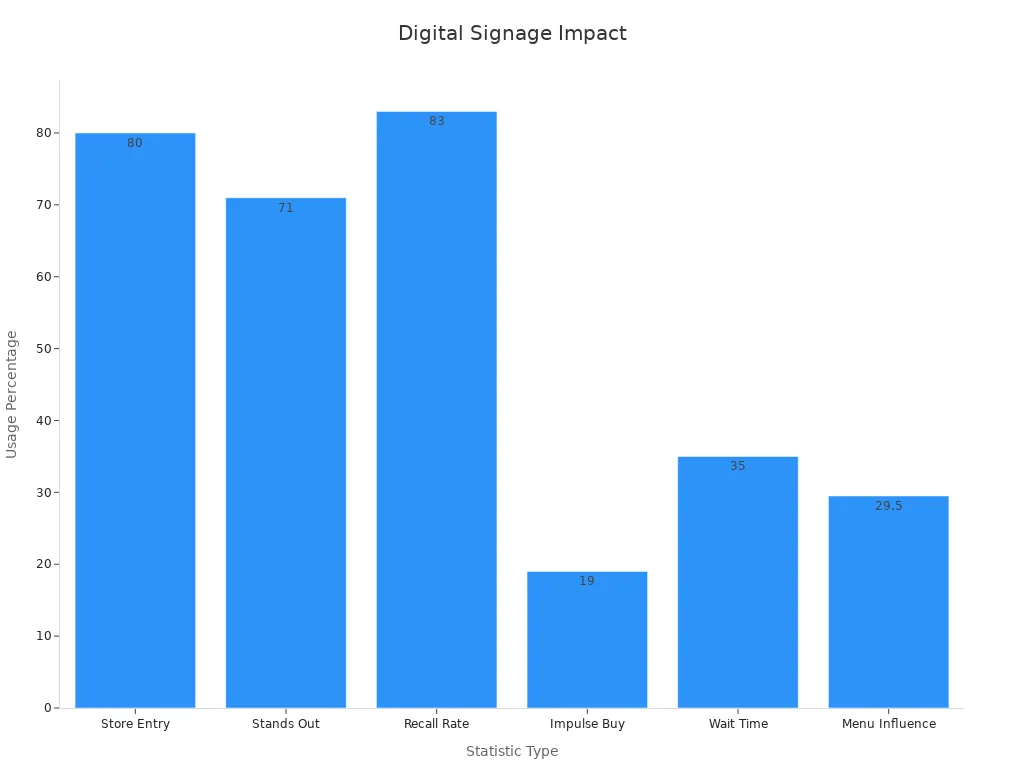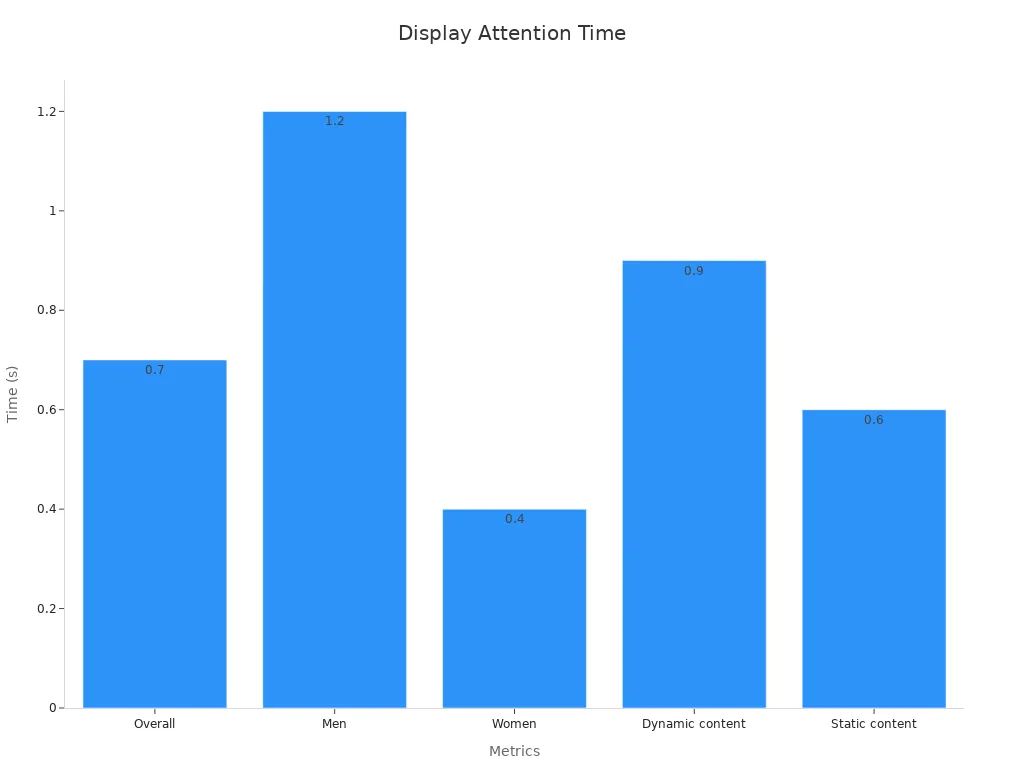How to Make a Digital Signage Display

Picture walking into a store and seeing a bright screen showing new deals. Or think of a hospital lobby where a screen helps you find your appointment. These are examples of digital signage displays. They are common—and for a good reason. Businesses using these screens see profits grow by 124%. Digital screens get 400% more attention than regular signs. Also, about 68% of people say they’re more likely to buy items shown on these screens. Want to make your own? Let’s get started and create one!
Key Takeaways
Digital signs can increase business profits by 124% and get 400% more attention than regular signs.
Pick the best hardware and software to show clear content and run smoothly.
Update your content often to keep it new and interesting. This keeps customers happy and interested.
Use free digital signage software to save money but still manage good content for your signs.
Check your setup often to find and fix problems. This keeps your digital signs working well and looking good.
What Is a Digital Signage Display?
Understanding Digital Signage
Digital signage uses screens to share information instead of paper signs. You’ve likely seen it before—like menus at fast-food places or flight info at airports. These screens use LCD, LED, or OLED technology to show things like text, pictures, videos, or animations. Special software helps control what’s on the screen. You can even update it online from anywhere.
A digital signage system usually includes:
Display screens: The screens that show the content.
Media players: Devices that store and play the content.
Content management software (CMS): A tool to manage and schedule content.
Connectivity infrastructure: Lets you update content remotely.
Digital signage isn’t just for sharing info—it makes things exciting. Some systems even use AI to show personalized content. Others let people touch the screen to explore options.
Benefits of Digital Signage Displays
Why use digital signage? It grabs attention. Bright screens are more noticeable than regular signs. People remember 83% of what they see on digital displays.
Businesses see great results too. Digital signage makes wait times feel 35% shorter. Restaurants say 8 out of 10 customers buy extra items after seeing digital ads. Stores with digital signage often see sales go up by 31.8%.
It’s not just about selling more. Digital signage makes customers 46% happier and brings them back again. It’s also flexible. Use it to show deals, give directions, or entertain people. Whether you own a small café or a big store, digital signage helps you connect with your customers better.
Essential Parts for a Digital Signage Display
Making a digital signage display needs three key parts: hardware, software, and internet. Each part is important to make sure your display works well and does what you need.
Picking the Right Hardware
Hardware is the main part of your digital signage system. It includes screens, media players, and other physical tools. Choosing good hardware makes your content look clear and run smoothly.
Here’s what to think about when picking hardware:
Screen Brightness: Indoor screens need 300-500 nits. Outdoor ones need 2000 nits or more for sunlight.
Media Player Power: For high-quality videos or many screens, pick a strong media player with good memory.
Compatibility: Make sure your hardware works with your content and fits the location.
Environment: Will it be inside or outside? Outdoor screens need weatherproofing and cooling systems.
Lighting: Check the area’s light. Bright places need brighter screens to show content clearly.
💡 Pro Tip: Buying good hardware now saves money on repairs later.
Looking at Software Choices
Software is like the brain of your signage system. It helps you design, control, and plan content for your screens. There are many software options, so you can find one that fits your needs and budget.
Here’s a quick look at some software options:
Software Vendor | Cost (per screen/month) | Key Features | Popularity |
|---|---|---|---|
Look Digital Signage | $5.4 | AI tool for easy content creation | Works for all business sizes |
ScreenCloud | $20 | Simple setup and growth | Great for small businesses |
Novisign | $18 | Flexible for different industries | Used on 20,000+ screens |
LG Electronics | N/A | Handles 1000 screens, works with LG hardware | N/A |
Samsung Electronics | N/A | Grows with needs, works with Samsung screens | N/A |
Sony | N/A | High-quality screens, workspace tools | N/A |
Think about your goals when picking software. Do you need something basic for one screen? Or do you want advanced tools like AI for content? Some platforms even offer free software, which is great for beginners.
Why Internet Connectivity Matters
Internet connects everything in your system. It lets you update your screen content from anywhere. Without it, you’d have to change content by hand, which takes time.
Cloud-based systems need the internet to work. They let you control screens from any location, even on vacation. They also track data to help improve your content over time.
🚀 Did You Know? Many free apps need the internet to sync and update content.
A strong internet connection keeps your system running without problems. Whether you have one screen or many, reliable internet ensures smooth performance.
Step-by-Step Guide to Setting Up a Digital Signage Display

Picking Budget-Friendly Digital Signage Hardware
Getting good digital signage hardware doesn’t need to cost a lot. You can find affordable options that work well if you plan carefully. First, decide if you need consumer or commercial-grade screens.
Consumer Displays: These are cheaper, costing $300 to $800. But they aren’t made for long use and may break faster.
Commercial Displays: These are pricier, around $1,000 to $3,000 or more. They last longer and come with better warranties, making them worth the cost.
Touch-enabled Screens: For interactive screens, expect to pay $2,000 or more.
Don’t forget the media player. Basic players cost $150 to $300. Advanced ones with extra features range from $300 to $500 or more.
💡 Pro Tip: Spending more on strong hardware now can save repair costs later.
Think about where your screen will go. Is it indoors or outdoors? Outdoor screens need to handle weather and bright sunlight. Indoor screens with 300-500 nits of brightness work fine.
Trying Free Digital Signage Software
If money is tight, free digital signage software can help. It has no upfront cost but still offers great tools to manage your content. Many free apps are easy to use, even for beginners.
Why choose free digital signage software? Here’s why:
Saves money: Start without spending anything.
Simple to use: Most apps are easy to learn.
Customizable: Use templates to match your brand.
Grows with you: Handle more screens as your business expands.
Remote control: Update screens from anywhere.
Some free apps also have active user groups. These communities share tips and solve common problems.
🚀 Did You Know? Free software often works with cloud systems. You can manage screens using your phone or laptop.
Making Content with Digital Signage Templates
You don’t need to be a designer to create great content. Digital signage templates make it simple. These pre-made layouts let you add your text, pictures, and videos.
Why use templates? Check out these stats:
Statistic | What It Means |
|---|---|
80% | People enter stores after seeing digital signage. |
71% | Digital signage stands out more than online ads. |
83% | People remember what they see on digital screens. |
19% | Shoppers buy on impulse after seeing digital ads. |
35% | Digital signage makes wait times feel shorter. |
29.5% | Digital menus influence customer choices. |
Templates save time and make your content look professional. They’re perfect for beginners. You can find free templates online for menus, schedules, and more.
🎨 Pro Tip: Use bright colors and big fonts to grab attention. Keep messages short since people only glance at screens for a few seconds.
With templates, you can quickly create content that grabs attention and boosts results.

Installing and Configuring the Display
Setting up a digital signage display is simpler than it seems. Follow these steps to get your screen working fast.
Step 1: Mounting the Screen
Pick a spot where people can easily see the screen. Think about busy areas with lots of foot traffic. After choosing the location, attach the screen securely. Use a strong wall mount or stand that fits the screen’s size and weight.
💡 Pro Tip: Outdoor screens need weatherproofing and protection from sunlight.
Step 2: Connecting the Media Player
Connect the media player to the screen using an HDMI cable. Make sure the player is powered on. If you use a Raspberry Pi, you can customize it for your needs.
Step 3: Configuring the Software
Install digital signage software on the media player. Free apps often have easy setup guides. Log in to the software and upload your content. Tools like Yodeck work well with most hardware.
Step 4: Testing the Setup
Test everything before using the display. Check if the screen shows content correctly. Ensure the internet connection works. Fix any problems you find.
Best Practice | Description |
|---|---|
Customization options | Raspberry Pi lets you adjust settings for better performance. |
Fast delivery | Raspberry Pi devices arrive quickly for urgent setups. |
Compatibility | Yodeck works with Raspberry Pi to prevent hardware issues. |
Reliable components | Yodeck uses high-quality parts to avoid failures. |
Follow these steps to set up a working digital signage display that impresses viewers.
Optimizing the Setup for Best Results
After setting up, make your display stand out. Optimizing ensures your digital signage works well and grabs attention.
Keep Content Fresh and Relevant
Interesting screens catch people’s eyes. Update your content often to keep it exciting. Free software lets you schedule updates and manage content from anywhere.
🚀 Did You Know? L’Occitane en Provence improved customer engagement by matching their digital signage to their brand.
Improve Speed and Flexibility
Digital signage lets you change content quickly. Unlike printed signs, updates happen instantly. Promotions can be added in seconds.
Speed: Quick updates keep your content fresh.
Interactivity: Touchscreens let customers explore options.
Flexibility: Change content easily without extra work.
Monitor Performance
Use tools to check how well your display works. Are people noticing your content? Are sales improving? Platforms like Yodeck track data to help you make changes.
Save Costs with Remote Management
Remote tools lower maintenance costs. Invicta Stores saved money by managing screens from one location.
💡 Pro Tip: Use bright colors and big fonts to grab attention. Keep messages short for quick viewing.
Optimizing your digital signage display boosts performance, saves money, and makes customers happy. Use these tips to get the best results from your setup.
Testing and Fixing Your Digital Signage Display
After setting up your digital signage, testing and fixing problems are important. These steps help make sure your display works well.
Checking the Display Setup
Testing shows if your hardware and software are working right. First, check simple things: Does the screen turn on? Is the content showing correctly? If yes, move to detailed checks.
Here are key numbers to check your display’s success:
Metric | Value |
|---|---|
Customers noticing the display | 35% |
Average attention time (all) | 0.7 seconds |
Average attention time (men) | 1.2 seconds |
Average attention time (women) | 0.4 seconds |
Average attention time (kids) | Highest of all groups |
Attention time (moving content) | 0.9 seconds |
Attention time (still content) | 0.6 seconds |
Videos or animations grab attention longer than still images. Use this to make your content more engaging.

💡 Pro Tip: Test your display during busy times to see how it performs when most people are around.
Fixing Common Problems
Even good setups can have problems. Here’s how to solve common ones:
Blank Screen:
Make sure the screen is on and connected to the media player.
Check if the HDMI cable is plugged in tightly.
Content Not Updating:
Check your internet connection. Many free apps need the cloud to update.
Restart the media player and review software settings.
Bad Display Quality:
Match the screen resolution to your content.
Clean the screen to remove dust or smudges.
Slow System:
Delete unused files to free up memory on the media player.
Upgrade to a stronger media player if needed.
🚀 Did You Know? Regularly cleaning and checking your hardware can stop most problems before they happen.
By testing and fixing issues quickly, your digital signage will stay effective and keep your audience interested.
Making a digital signage display is simple. Use easy tools and cloud-based platforms to create a budget-friendly system. Whether you want affordable options or interactive features, the right media player and software are key. Digital signage ads catch attention and share messages well. Begin now to change your space with easy and useful digital signage solutions.
FAQ
What is the best screen size for digital signage?
The ideal screen size depends on your location. For small spaces, 32–43 inches work well. Larger areas like malls or lobbies need screens 55 inches or bigger. Always match the screen size to the viewing distance.
Can I use my TV as a digital signage display?
Yes, you can! Many TVs work as digital signage screens. Just connect a media player and install software. However, TVs aren’t built for long hours, so they may wear out faster than commercial-grade screens.
Do I need a professional designer for my content?
Not at all! Free templates make it easy to design content yourself. Add your text, images, and videos to create professional-looking displays. Bright colors and bold fonts help grab attention.
How much does it cost to set up digital signage?
Costs vary based on hardware and software. Consumer screens start at $300, while commercial ones cost $1,000 or more. Free software can reduce expenses. Budget-friendly setups are possible with careful planning.
Can I update my display remotely?
Absolutely! Cloud-based software lets you update content from anywhere. You can use your phone or laptop to make changes instantly. This saves time and keeps your display fresh and relevant.
See Also
Understanding Digital Signage Displays: Key Features Explained
Exploring Digital Signage Displays: Advantages and Best Practices
The Role of Digital Signage Technology in Modern Communication
Future Trends in Digital Signage Displays: Uses and Advantages
Enhancing Customer Engagement Through Effective Digital Signage

